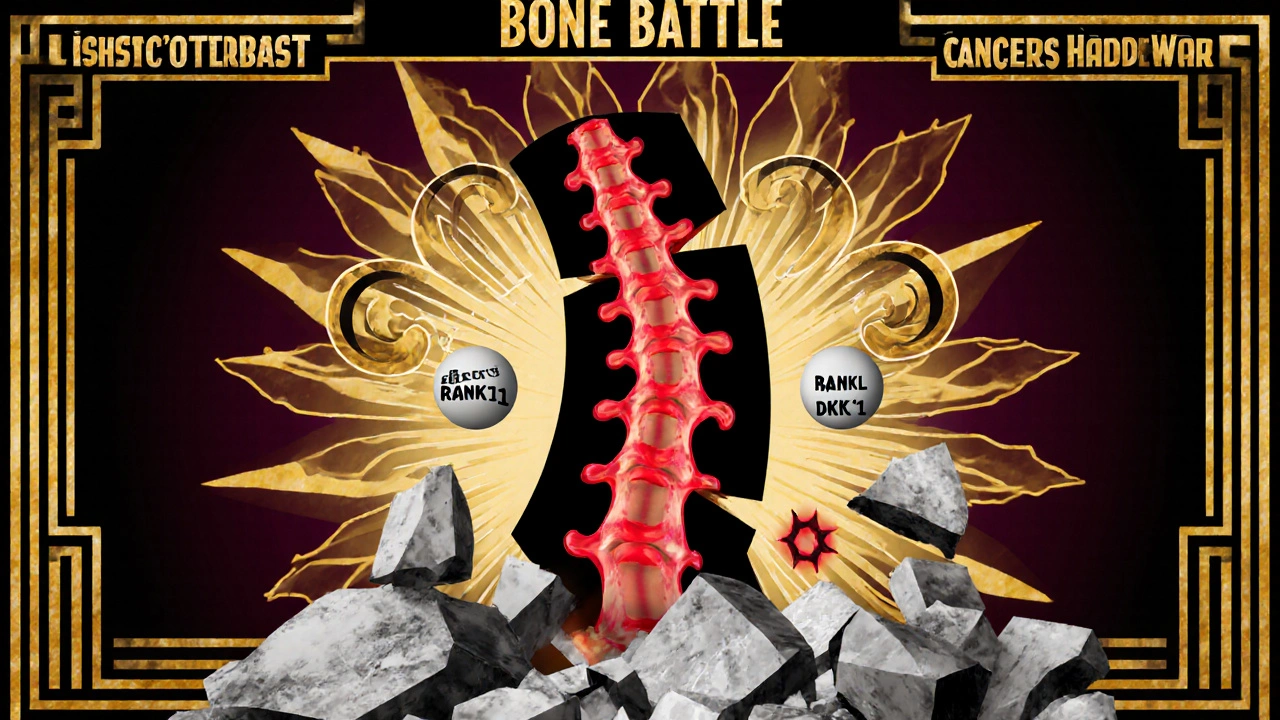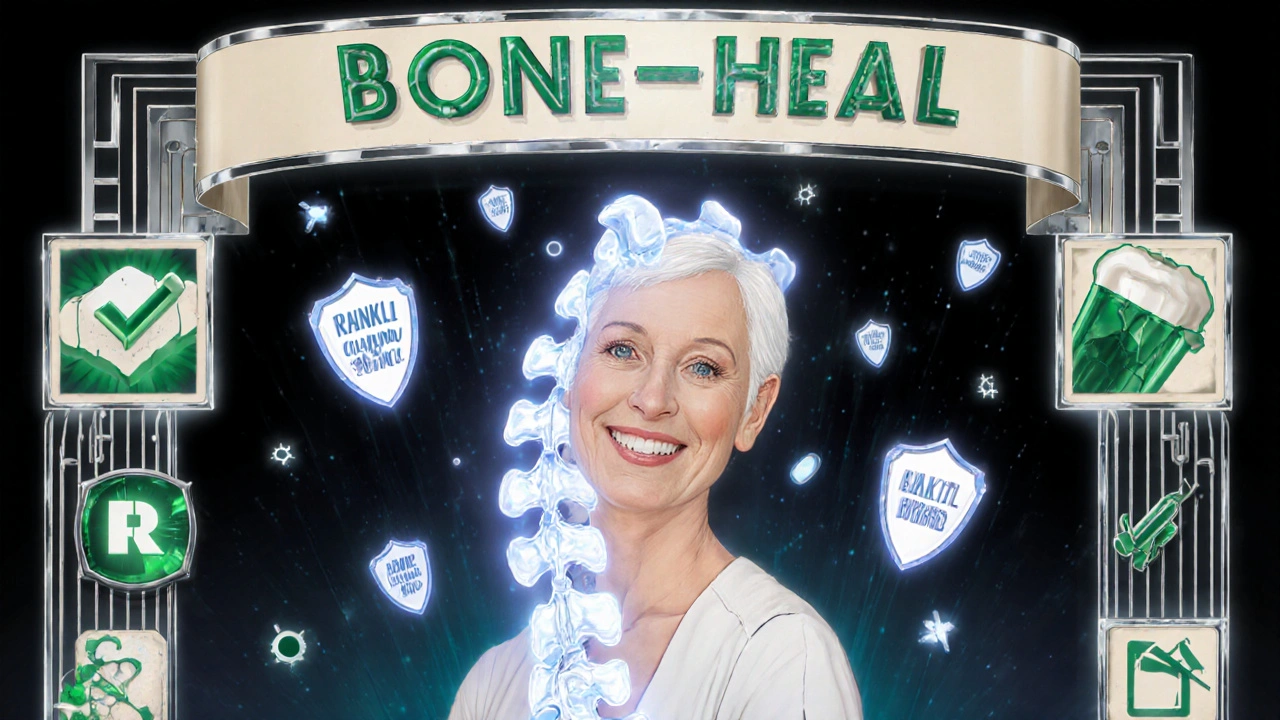Multiple Myeloma Bone Disease and the New Drugs Changing Treatment
 Nov, 12 2025
Nov, 12 2025
Over 80% of people diagnosed with multiple myeloma will develop serious bone damage. It’s not just a side effect-it’s a core part of the disease. These aren’t ordinary fractures or weak bones. The bone destruction in multiple myeloma looks like holes punched out by a drill, visible on X-rays as osteolytic lesions. And unlike osteoporosis, where bone breaks down slowly, this damage is aggressive, fast, and driven by the cancer itself.
How Myeloma Turns Bone Into a Battlefield
Your bones are never still. They’re constantly being broken down and rebuilt in a balanced process called remodeling. Osteoclasts chew away old bone. Osteoblasts lay down new bone. In multiple myeloma, that balance shatters.
Myeloma cells hide in the bone marrow and send out signals that flip the script. They ramp up osteoclasts-cells that eat bone-while shutting down osteoblasts, the builders. The result? Bone disappears faster than it can be replaced. This isn’t random. It’s targeted. The destruction happens right where the cancer cells are clustered.
Three key pathways drive this chaos:
- RANK/RANKL/OPG: Myeloma cells boost RANKL, a signal that activates osteoclasts, while crushing OPG, the natural brake. The ratio of RANKL to OPG can be 3 to 5 times higher than in healthy people.
- DKK1 and sclerostin: These proteins, secreted by myeloma cells, block the Wnt signaling pathway-the main switch that tells osteoblasts to grow new bone. Patients with DKK1 levels above 48.3 pmol/L have over three times more bone lesions.
- Notch signaling: Myeloma cells talk directly to osteocytes (the most common bone cells), turning on Notch receptors. This further increases RANKL and suppresses bone repair.
It’s a vicious cycle: bone breakdown releases growth factors that feed myeloma cells, which then make even more signals to destroy more bone. The bone isn’t just a victim-it’s an accomplice.
The Human Cost: Pain, Fractures, and Hospital Stays
For patients, this isn’t abstract science. It’s constant pain. It’s the fear of standing up and hearing a crack. It’s being told you can’t lift your grandchild because your spine might collapse.
One in three patients will suffer a pathological fracture. Between 5% and 10% will develop spinal cord compression-a medical emergency. Nearly one in four will have dangerously high calcium levels from bone dissolving into the bloodstream.
These aren’t rare events. They’re routine. Bone complications are the second most common reason myeloma patients end up in the hospital, after infections. The average hospital stay? Over eight days. And even with treatment, nearly 70% of myeloma-related suffering comes from bone damage.
Patients on standard bone drugs report persistent pain. On Reddit’s myeloma community, 68% said their bone pain didn’t improve with bisphosphonates. And then there’s MRONJ-medication-related osteonecrosis of the jaw. About 42% of patients on long-term bone drugs need dental surgery because their jawbone starts dying.
Current Standard Care: Bisphosphonates and Denosumab
For years, the only tools doctors had were bisphosphonates-zoledronic acid or pamidronate-given as monthly IV infusions. These drugs slow down osteoclasts. They reduce skeletal-related events by 15-18% compared to no treatment.
Then came denosumab, a monthly shot under the skin that blocks RANKL directly. It’s just as effective as bisphosphonates at preventing fractures, but it doesn’t hurt the kidneys. That’s a big deal-many myeloma patients already have kidney damage from the disease.
Still, neither drug rebuilds bone. They only slow the decay. Patients get fewer fractures, but their bones don’t heal. And the cost? Denosumab runs about $1,800 per dose. Generic zoledronic acid? Around $150. Insurance coverage varies wildly. In the U.S., 78% of patients get denosumab. In Europe, it’s just 42%.

The New Wave: Drugs That Actually Heal Bone
The next generation of drugs doesn’t just stop bone loss-they try to fix it.
Anti-sclerostin antibodies like romosozumab and blosozumab are the most promising. They block sclerostin, the protein that shuts down bone building. In a 2021 trial with 49 myeloma patients, romosozumab increased spine bone density by 53% in just 12 months. Patients also reported 35% less pain.
Anti-DKK1 therapies like DKN-01 target the other major blocker of bone repair. In a small 2020 trial, DKN-01 cut bone resorption markers by 38%. It’s not a cure, but it’s a step toward healing.
Gamma-secretase inhibitors like nirogacestat block Notch signaling. In lab models, they reduced bone lesions by 62%. Human trials are just starting.
These aren’t just lab curiosities. The FDA has approved a new low-dose zoledronic acid (Zometa-LD) with less kidney risk. And the phase III BONE-HEAL trial-testing romosozumab in 450 patients-is now recruiting. If it works, we could see the first bone-healing drug for myeloma by 2027.
Why We Still Don’t Have the Full Picture
Here’s the catch: even the most exciting new drugs haven’t yet proven they extend life. They improve bone scans. They reduce pain. But survival? Still unclear.
Dr. Kenneth Anderson from Dana-Farber puts it bluntly: we need better biomarkers. Not everyone with myeloma has the same bone disease. Some have rapid destruction. Others have slow, creeping damage. We don’t yet know which patients will benefit most from anti-sclerostin drugs versus anti-DKK1.
Also, these drugs come with risks. Anti-sclerostin agents can cause low calcium-12.3% of patients need supplements. Gamma-secretase inhibitors cause severe rashes in two-thirds of trial participants. We’re learning how to manage them, but we’re not there yet.

What Patients Should Ask Their Doctors
If you or someone you love has multiple myeloma, here’s what to ask:
- Has my bone disease been fully assessed with a whole-body CT or PET-CT? (Not just an X-ray.)
- Am I on the best bone drug for my kidneys and lifestyle? (IV vs. shot? Cost? Side effects?)
- Have I had a dental checkup within 30 days of starting treatment? (To prevent jaw bone death.)
- Am I getting enough calcium and vitamin D? (Most patients need 1,200 mg calcium and 800-1,000 IU vitamin D daily.)
- Is there a clinical trial I might qualify for? (Especially if I’m still having bone pain or new lesions.)
Resources like the International Myeloma Foundation’s Bone Disease Management Guide and the Myeloma Beacon’s Bone Health Toolkit are free, evidence-based, and updated for 2025. Download them. Print them. Bring them to your next appointment.
The Future: Healing, Not Just Preventing
The goal is no longer just to prevent fractures. It’s to reverse them.
Researchers are now testing bispecific antibodies that attack myeloma cells and block bone-damaging signals at the same time. RNA therapies are being developed to silence DKK1 production. And personalized medicine-using blood tests to measure bone turnover markers-could soon tell us which drug to give, and when.
By 2030, we may look back at today’s treatments the way we now look at early chemotherapy: crude, reactive, and incomplete. The future is about healing bone, not just slowing its destruction.
It’s not science fiction. It’s happening in labs and clinics right now. And for patients who’ve lived with broken bones for years, that’s not just progress. It’s hope.
Is bone damage in multiple myeloma reversible with current treatments?
Current standard treatments like bisphosphonates and denosumab stop further bone destruction but do not repair existing damage. They reduce fractures and pain, but bones don’t rebuild. New agents like romosozumab and anti-DKK1 drugs, currently in clinical trials, are the first to show actual bone formation and healing in patients.
What’s the difference between denosumab and zoledronic acid?
Denosumab is a monthly injection under the skin that blocks RANKL, a key signal for bone breakdown. Zoledronic acid is a monthly IV infusion that directly kills osteoclasts. Denosumab doesn’t affect kidney function, making it safer for patients with kidney issues. Zoledronic acid is cheaper but can cause kidney damage, fever, and jaw bone problems. Most patients prefer denosumab for convenience and safety, though cost and insurance vary.
Why do myeloma patients need dental checkups before starting bone drugs?
Bisphosphonates and denosumab can cause osteonecrosis of the jaw (MRONJ), a rare but serious condition where the jawbone dies and becomes exposed. This risk is highest after dental surgery or tooth extraction. A dental exam and any needed procedures should be done before starting treatment to prevent this. Avoid invasive dental work while on these drugs unless absolutely necessary.
Are the new bone-healing drugs available now?
No, not yet. Anti-sclerostin drugs like romosozumab and anti-DKK1 therapies like DKN-01 are still in clinical trials. The phase III BONE-HEAL trial for romosozumab is ongoing and expected to complete in 2027. These drugs are not FDA-approved for multiple myeloma yet, though romosozumab is approved for osteoporosis in postmenopausal women.
Can I stop bone drugs if my myeloma is in remission?
No. Even if your cancer is under control, bone disease can still progress. Guidelines recommend continuing bone-modifying agents as long as you’re on active myeloma treatment. Once treatment stops, your doctor may continue the drug for up to 2 years, then reassess based on bone scans and symptoms. Stopping too early can lead to sudden fractures.
Chrisna Bronkhorst
November 12, 2025 AT 21:26Myeloma bone damage isn't just holes in bone-it's a full-on civil war inside your marrow. Osteoclasts are the rebels, osteoblasts are the cops who got disarmed, and the cancer? The warlord holding the remote to both.
They don't just break bone-they rewire the whole damn system. And yeah, denosumab helps, but it's like putting duct tape on a collapsing bridge. We need architects, not repairmen.
Amie Wilde
November 13, 2025 AT 05:16My jaw bone died last year from denosumab. No dental checkup. Big mistake. Don't wait till it's too late.
Gary Hattis
November 13, 2025 AT 10:40Let’s be real-this isn’t just about science. It’s about dignity. I watched my mom go from hiking weekends to being afraid to stand up. That’s the real cost.
These new drugs? They’re not just molecules. They’re the first real shot at giving people back their bodies. Romosozumab’s 53% spine density jump? That’s not a stat-it’s a life.
And yeah, the side effects suck. But so does living with a spine that might crack if you sneeze. We’ve been settling for too long.
Esperanza Decor
November 15, 2025 AT 09:17I’ve been on zoledronic acid for 3 years. Kidneys are fine, but I hate the IV. Monthly. For years. Denosumab sounds better-until you see the price tag. My insurance only covers the generic. I get the $150 shot, not the $1800 one.
And don’t even get me started on the dental horror stories. I had to get two teeth pulled before starting. Now I can’t even chew an apple without worrying.
But I’d rather be alive and chew soft food than dead and have perfect teeth.
Deepa Lakshminarasimhan
November 16, 2025 AT 14:11They say these drugs are healing bone… but who’s really funding this? Pharma. Always pharma.
Why haven’t they tried cheaper, natural ways? Magnesium? Vitamin K2? Bone broth? No one talks about that.
And why are we only hearing about drugs that block signals? What if the real problem is toxins? Heavy metals? EMF? They’re not testing that. They’re just selling more drugs.
They want you dependent. Keep you on the drip. Forever.
Erica Cruz
November 16, 2025 AT 14:39Romosozumab increased bone density by 53%? That’s the exact number pharma uses to make you feel like you’re getting a miracle. But did it extend survival? No.
And let’s be honest-this whole ‘bone healing’ narrative is just a fancy marketing pivot. We’ve been sold ‘hope’ for decades. The real win? Not dying from a fracture before your cancer kills you.
It’s not progress. It’s rebranding.
Johnson Abraham
November 18, 2025 AT 10:22so like… these new drugs make bone grow back? cool. but i heard they give you rashes like you got attacked by bees. and what if your calcium drops? you just gonna chug milk all day?
also why is this only for rich people? denosumab is 1800 a shot? bro i pay rent on less than that.
also why do i need a whole body ct just to check my bones? can’t i just say ‘my spine hurts’ and get a xray? lol
Shante Ajadeen
November 20, 2025 AT 03:13I’m a caregiver. I’ve seen this firsthand. The fear in a patient’s eyes when they hear ‘osteolytic lesion’-it’s not just medical jargon. It’s a death sentence they can feel in their bones.
But these new trials? They’re real. They’re not magic, but they’re the first time we’ve seen bone actually rebuild. Not just stop breaking.
And yes, the side effects matter. But so does the pain. So does the dignity.
Ask your doctor about trials. Don’t wait. There’s real hope here. Not hype. Real.
dace yates
November 20, 2025 AT 09:53Is there any data on whether anti-sclerostin drugs affect myeloma cell proliferation directly? Or is it purely bone-focused? I’m wondering if healing bone might also starve the cancer by removing its microenvironment.
Danae Miley
November 21, 2025 AT 19:47Correction: The BONE-HEAL trial is recruiting, but it’s not phase III yet-it’s still phase II. Phase III begins in 2026. Please don’t misquote trial stages. It misleads patients.
Charles Lewis
November 23, 2025 AT 14:57As a clinician who’s managed over 200 myeloma patients, I’ve seen the evolution of bone care-from nothing to zoledronic acid, to denosumab, to now the dawn of true bone regeneration.
What’s often missed is that bone healing isn’t just about density-it’s about architecture. The trabecular network must reform, not just thicken. Early data from romosozumab shows not just increased mass but restored connectivity-something bisphosphonates never achieved.
And yes, the cost is a crisis. But we must not let reimbursement barriers delay access to therapies that could reduce hospitalizations by 40%.
Patients aren’t asking for miracles. They’re asking for the chance to hold their grandchildren without fear. That’s not a luxury. It’s care.